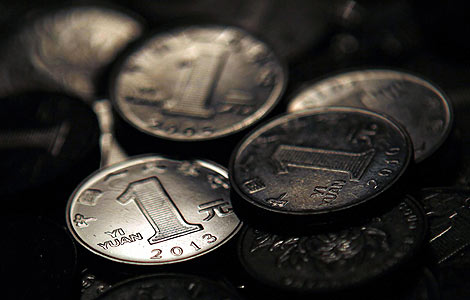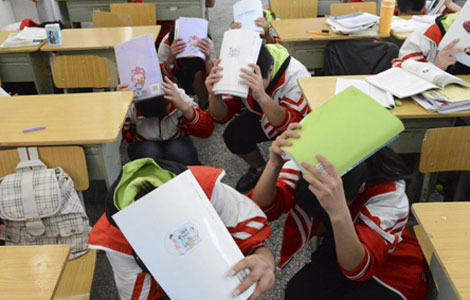
|
 |
|
One Chinese yuan coins are seen in this photo illustration taken in Shanghai April 7, 2013. [Photo/Agencies] |
BEIJING - China's new yuan-denominated lending stood at 2.76 trillion yuan (441 billion U.S. dollars) in the first quarter, up 294.9 billion yuan year on year, the People's Bank of China, or the central bank, announced on Thursday.
New loans denominated in foreign currencies stood at 70.9 billion U.S. dollars, the bank said in a statement.
It said that the country's social financing, a measure of funds raised by entities in the real economy, amounted to 6.16 trillion yuan in the first quarter, up 2.27 trillion yuan from the same period last year.
In March, both new loans and social financing rebounded significantly, the data showed. New yuan-denominated lending reached 1.06 trillion yuan in March, 440 billion yuan more than that of February. Social financing hit 2.54 trillion yuan, 1.48 trillion yuan more than the previous month.
The data pointed to a recovery in corporate financing demand, analysts said. As a leading economic indicator, the rebound in social financing sends a signal that China's economic recovery is on solid footing, they said.
The money supply also rose. By the end of March, the broad measure of money supply (M2), which covers cash in circulation and all deposits, increased 15.7 percent year on year to 103.61 trillion yuan, the statement said.
The increase was up 0.5 percentage points from the end of February and 1.9 percentage points higher than the year-on-year growth registered at the end of 2012.
Meanwhile, the narrow measure of money supply (M1), which covers cash in circulation plus current corporate deposits, jumped 11.9 percent year on year to 31.12 trillion yuan, while the growth rate was 2.4 percentage points higher than that of the end of February.
Analysts attributed the ballooning money supply to a substantial increase in deposits and an increase in Chinese banks' forex purchases.
Deposits surge, inflationary concerns mount
The central bank data showed that new yuan-denominated deposits in March hit 4.22 trillion yuan, accounting for 69 percent of the first quarter's total.
"This inevitably affected M2," said Zhao Qingming, an economist at China Construction Bank.
Data showed that M2 rose from 13 trillion yuan in 2000 to 97.4 trillion yuan in 2012. The proportion of M2 in the country's GDP also ascended, triggering inflationary concerns.
China's fast economic growth needs the support of a certain size of M2, said Zhang Qizuo, an economist working on the strategic development of the G20 and emerging economies.
With regard to inflation, economists have maintained that the M2 increase has no inevitable connection with inflation.
"China's inflation cannot be explained simply by one reason. There are complicated factors behind inflationary pressures," said Yu Yongding, a member of the Chinese Academy of Social Sciences.
Situations in other major economies support the argument. For instance, Japan's consumer prices registered a negative growth, with the proportion of money supply in its GDP reaching as much as 238 percent.
Nevertheless, the unexpected M2 surge means accelerated economic restructuring is needed, said Li Daokui, a former advisor to China's central bank, adding that efforts should be made to expand the country's bond and capital markets.
The country should be aware of the fact that its economy is increasingly monetarized, said Liu Yuhui, a financial researcher with the Chinese Academy of Social Sciences, a government think tank.
According to a government work report delivered by former Premier Wen Jiabao on March 5, the central bank expects M2 to expand by just 13 percent this year, compared to forecasts of 16 percent in 2011 and 14 percent in 2012.
Forex purchases up, rising yuan eyed
The M2 surge is related to an increase in Chinese banks' forex purchases, said E Yongjian, financial analyst with the Bank of Communications.
China's central bank and commercial banks saw their yuan funds outstanding for foreign exchange continue to increase amid expectations of a rising yuan as the country's economy gradually recovers.
After buying a record high of 683.7 billion yuan (109.2 billion U.S. dollars) in foreign currencies in January, Chinese financial institutions purchased 295.4 billion yuan in foreign exchange in February, the third straight month of increases, data from the central bank showed.
As of the end of February, Chinese financial institutions' total yuan funds outstanding for foreign exchange amounted to 26.83 trillion yuan.
Analysts attributed the continuing increases to companies' willingness to hold assets in yuan, as its value has trended upward. On Wednesday, the yuan hit a record high against the U.S. dollar.
The phenomenon also suggests increasing capital inflow to China against the backdrop of a gentle recovery in the economy.
"The capital inflow and China's widening trade surplus in the first quarter are the major reasons for the yuan's appreciation pressures," noted Wang Tao, chief economist with UBS Securities.
To mop up excess liquidity resulting from the funds, the People's Bank of China has been draining liquidity via open market operations.
This week, 76 billion yuan was removed from money markets through 28-day repos in the bank's regular open market operations
Considering the 59 billion yuan in central bank repos and bills maturing, it actually withdrew 17 billion yuan from the markets, a softer move from a week earlier, which analysts read as the bank's attempt to keep moderate liquidity to support tepid economic recovery in the context of lower-than-expected inflation data.
The country's consumer price index rose 2.1 percent year on year in March, down from a 10-month high of 3.2 percent in February, while the producer price index, which measures wholesale inflation, fell for the 13th consecutive month.
The mild inflation and relatively gentle recovery suggests little possibility of monetary tightening, while ample liquidity in the markets makes policy easing equally unlikely, according to analysts.
"The monetary policies will be set to neutral," said Peng Wensheng, chief economist at the China International Capital Corporation.
The Chinese economy saw its slowest growth in 13 years in 2012, increasing by 7.8 percent, although growth began to show signs of recovery in the fourth quarter of last year.
China is due to release key economic data for the first quarter next week.







